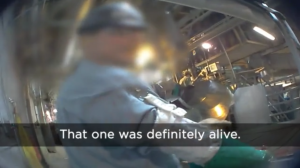An undercover video taken at one of the nation’s largest pork producers shows pigs being dragged across the floor, beaten with paddles, and sick to the point of immobility. By law, pigs are supposed to be rendered unconscious before being killed, but many are shown writhing in apparent pain while bleeding out, suggesting that they weren’t properly stunned. “That one was definitely alive,” a worker says.
 The video also appears to show pigs with puss-filled abscesses being sent down the line. Others are covered in feces.
The video also appears to show pigs with puss-filled abscesses being sent down the line. Others are covered in feces.
“If the USDA is around, they could shut us down,” says a worker, wearing a bright yellow apron, standing over the production line.
The graphic video — available on YouTube in an edited form — was covertly filmed by a contracted employee of Compassion Over Killing, a nonprofit animal rights group that claims to have infiltrated an Austin, Minn., facility run by Quality Pork Processors (QPP), a supplier of Hormel Foods, the maker of Spam and other popular processed meats. The group has turned over the 97-minute unedited video to the U.S. Department of Agriculture (USDA), which has raised serious concerns about the conditions at the QPP facility and pledged a thorough investigation. A reporter has also seen the full-length video provided by the group.
“The actions depicted in the video under review are appalling and completely unacceptable, and if we can verify the video’s authenticity, we will aggressively investigate the case and take appropriate action,” said USDA spokesman Adam Tarr, adding that the agency can’t comment definitively in the middle of the probe.
QPP, which has seen both the edited and unedited versions, says the edited film makes it look as though there were violations when, in fact, there were none.
“Early on, there may very well be contamination present in the process, but we have multiple interventions that ensure that it will not only be visually removed, but completely removed,” said Nate Jansen, who is the vice president of human resources and quality services at QPP. “Had it been allowed to show the entire sequence of these events, all of these hogs were all handled appropriately.”
To gain access to the QPP facility, the Compassion Over Killing contractor applied for five months for jobs at meat processing companies and was eventually hired at QPP. Compassion Over Killing requested the person’s name not be disclosed because he still works at QPP, but showed a pay stub indicating employment there. The person did not describe on his job applications his affiliation with the activist group.
“I don’t think you can look at the video along with the USDA guidelines and say that QPP is following the law,” said Ted Genoways, the author of “The Chain: Farm, Factory, and the Fate of Our Food,” and has seen the video but is not associated with the group. “This plant is the symbol of everything that is wrong with the meat industry.”
In particular, the video shines a light on a government-approved pilot program, known as the HACCP-Based Inspection Models Project (HIMP), which allows processors like QPP to assume more responsibility over the inspection process.
The company is one of five pork processors participating in the HIMP program, which the Food Safety and Inspection Service (FSIS) first launched in the late 1990s. As part of the initiative, the government substantially changed the way it oversees meat production, more than doubling the number of safety checks (from 11 to 24) within a facility and reallocating government inspectors to focus more closely on food safety. The goal, as stated on the agency’s Web site, was to “produce a flexible, more efficient, fully integrated” system.
In the HIMP inspection model, three government inspectors are stationed on the production line, compared to the usual seven who oversee the handling of carcasses in the traditional system. In both, an additional offline inspector is free to move around. The reduction in government inspectors dedicated to checking hogs on the line has allowed the government to save money by reducing its inspection force. It has also allowed plants to increase their line speed — on average, participants in the pilot program process roughly 120 extra hogs per hour, according to the USDA.
The USDA speaks highly of the program, which it has repeatedly defended. “Obviously, we believe that the model is an appropriate one,” said Phil Derfler, the deputy administrator at FSIS. “That’s why we went ahead with the rule-making in order to adopt it — it’s an improvement on the traditional system.”
But Lisa Winebarger, who serves as a legal counsel to Compassion Over Killing and helped bring the investigation to the USDA, said QPP is violating those directives.
“I understand that QPP is denying any wrongdoing, but we can assure you that much of what we have documented are serious problems labeled as ‘egregious inhumane treatment’ and ‘egregious noncompliances'” by the government’s directives, she said.

 that are not properly cleaned and sanitized.
that are not properly cleaned and sanitized. My Dr. Oz friend
My Dr. Oz friend